commonly known as the stealth bomber, was an ambitious project, to say the least. In the 1970s, the U.S. military wanted a replacement for the aging B-52 bomber. They needed a plane that could carry nuclear bombs across the globe, to the Soviet Union, in only a few hours. And they wanted it to be nearly invisible to enemy sensors.
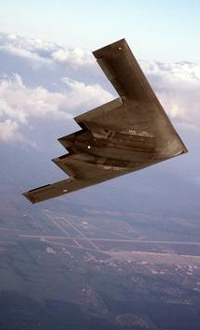 As you might expect, hiding a giant plane is no easy task. Northrop Grumman, the defense firm that won the bomber contract, spent billions of dollars and nearly 10 years developing the top secret project. The finished product is a revolutionary machine -- a 172-foot wide flying wing that looks like an insect to radar scanners! The craft is also revolutionary from an aeronautics perspective: It doesn't have any of the standard stabilizing systems you find on a conventional airplane, but pilots say it flies as smoothly as a fighter jet.
As you might expect, hiding a giant plane is no easy task. Northrop Grumman, the defense firm that won the bomber contract, spent billions of dollars and nearly 10 years developing the top secret project. The finished product is a revolutionary machine -- a 172-foot wide flying wing that looks like an insect to radar scanners! The craft is also revolutionary from an aeronautics perspective: It doesn't have any of the standard stabilizing systems you find on a conventional airplane, but pilots say it flies as smoothly as a fighter jet.
A Flying Wing
An ordinary airplane consists of a fuselage (the main body), two wings and three rear stabilizers attached to the tail. The wings generate lift, hoisting the fuselage into the air. The pilot steers the plane by adjusting flaps on the wings and the stabilizers. Moving the flaps changes how the air flows around the plane, causing the plane to ascend, descend and turn. The stabilizers also keep the plane level. (See How Airplanes Work to find out how these components work together.)
The B-2 bomber has a completely different design: It's one big wing, like a boomerang.
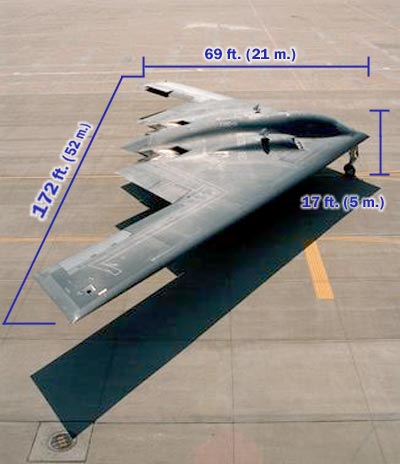 This flying wing design is much more efficient than a conventional plane. Instead of separate wings supporting all the weight of the fuselage, the entire craft works to generate lift. Eliminating the tail and fuselage also reduces drag -- the total force of air resistance acting on the plane.
This flying wing design is much more efficient than a conventional plane. Instead of separate wings supporting all the weight of the fuselage, the entire craft works to generate lift. Eliminating the tail and fuselage also reduces drag -- the total force of air resistance acting on the plane.
Greater efficiency helps the B-2 travel long distances in a short period of time. It's not the fastest craft around -- the military says it's high subsonic, meaning its top speed is just under the speed of sound (around 1,000 ft/sec or 305 m/s) -- but it can go 6,900 miles (11,000 km) without refueling and 11,500 miles (18,500 km) with one in-flight refueling. It can get anywhere on Earth on short notice.
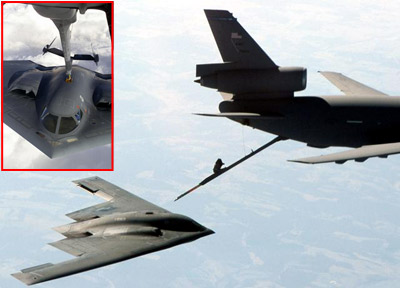 The B-2 has four General Electric F-118-GE-100 jet engines, each of which generates 17,300 pounds of thrust. Just as in an ordinary plane, the pilot steers the B-2 by moving various flaps on the wings. As you can see in the diagram below, the B-2 has elevons and rudders along the trailing edge of the plane. Just like the elevator and aileron flaps on a conventional plane, the elevons change the plane's pitch (up and down movement) and roll (rotation along the horizontal axis). The elevons and rudders also control the plane's yaw (rotation along the vertical axis).
The B-2 has four General Electric F-118-GE-100 jet engines, each of which generates 17,300 pounds of thrust. Just as in an ordinary plane, the pilot steers the B-2 by moving various flaps on the wings. As you can see in the diagram below, the B-2 has elevons and rudders along the trailing edge of the plane. Just like the elevator and aileron flaps on a conventional plane, the elevons change the plane's pitch (up and down movement) and roll (rotation along the horizontal axis). The elevons and rudders also control the plane's yaw (rotation along the vertical axis).
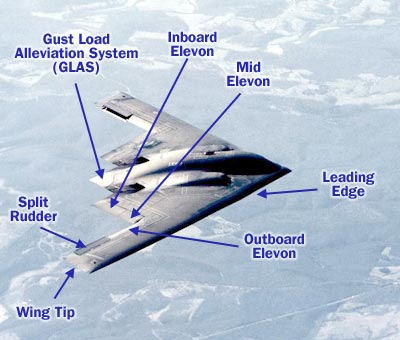 Flying wings have been around for a long time, but in the past, they suffered from major stability problems. Without the rear stabilizers, the plane tends to rotate around its yaw axis unexpectedly. The U.S. military didn't go for Northrop Grumman's earlier flying wing designs from the 1940s mainly because of these concerns.
Flying wings have been around for a long time, but in the past, they suffered from major stability problems. Without the rear stabilizers, the plane tends to rotate around its yaw axis unexpectedly. The U.S. military didn't go for Northrop Grumman's earlier flying wing designs from the 1940s mainly because of these concerns.
By the 1980s, advancements in computer technology made the flying wing a more viable option. Northrup Grumman built the B-2 with a sophisticated fly-by-wire system. Instead of adjusting the flaps through mechanical means, the pilot passes commands on to a computer, which adjusts the flaps. In other words, the pilot controls the computer and the computer controls the steering system.
Out of Sight
Northrop Grumman's primary goal for the B-2 was stealth, or low observability. Simply put, stealth is the ability to fly undetected through enemy airspace. Ideally, a stealth aircraft will be able to reach and destroy desired targets without ever engaging the enemy in combat.
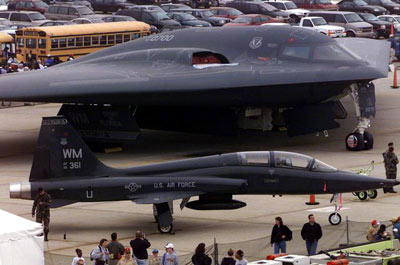 To do this, the aircraft needs to be nearly invisible in a number of different ways. Obviously, it needs to blend in with the background visually, and it needs to be very quiet. More importantly, it needs to hide from enemy radar as well as infrared sensors. It also needs to conceal its own electromagnetic energy.
To do this, the aircraft needs to be nearly invisible in a number of different ways. Obviously, it needs to blend in with the background visually, and it needs to be very quiet. More importantly, it needs to hide from enemy radar as well as infrared sensors. It also needs to conceal its own electromagnetic energy.
The B-2's flat, narrow shape and black coloration help it fade into the night. Even in the daytime, when the B-2 stands out against blue sky, it can be hard to figure out which way the plane is going. The B-2 emits minimal exhaust, so it doesn't leave a visible trail behind it.
As with most planes, the B-2's noisiest component is its engine system. But unlike a passenger jet or B-52, the B-2's engines are buried inside the plane. This helps muffle the noise. The efficient aerodynamic design helps keep the B-2 quiet as well, because the engines can operate at lower power settings.
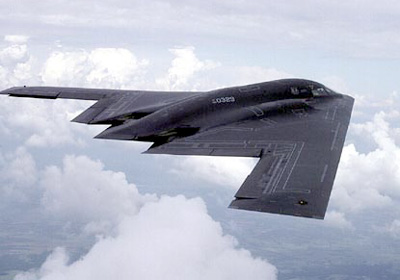 The engine system also works to minimize the plane's infrared (heat) signature. Infrared sensors, including those on heat-seeking missiles, typically pick up on hot engine exhaust. In the B-2, all of the exhaust passes through cooling vents before flowing out of the rear ports. Putting the exhaust ports on the top of the plane further reduces the infrared signature, since enemy sensors would most likely scan below the plane.
The engine system also works to minimize the plane's infrared (heat) signature. Infrared sensors, including those on heat-seeking missiles, typically pick up on hot engine exhaust. In the B-2, all of the exhaust passes through cooling vents before flowing out of the rear ports. Putting the exhaust ports on the top of the plane further reduces the infrared signature, since enemy sensors would most likely scan below the plane.
The B-2 has two major defenses against radar detection. The first element is the plane's radar-absorbent surface. The radio waves used in radar are electromagnetic energy, just like light waves. In the same way that certain materials absorb light very well (black paint, for example), some materials are particularly good at absorbing radio waves.
The B-2's body is mainly composed of composite material -- combinations of various lightweight substances. The composite material used in the B-2 bomber is specifically designed to absorb radio energy with optimum efficiency. Parts of the B-2, such as the leading edge, are also covered in advanced radio-absorbent paint and tape. These materials are very expensive, and the Air Force has to reapply them regularly. After every flight, repair crews have to spend many hours examining the B-2 to make sure it's fit for stealth missions.
Highly reflective metal components, such as the plane's engines, are all housed inside the composite body. Air flows into the intake ports, though an S-shaped duct and down to the engines. The bombs are also mounted inside the plane, and the landing gear fully retracts after take-off.
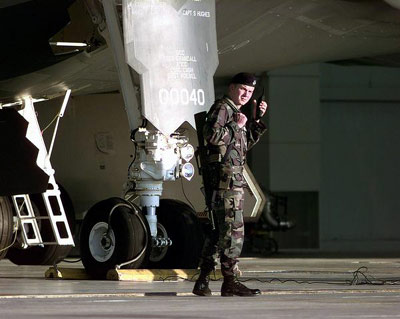 The second element in radar invisibility is the plane's shape. Radio waves bounce off planes in the same way light bounces off a mirror. A flat, vertical mirror will bounce your image straight back to you -- you'll see yourself. But if you tilt the mirror 45 degrees, it will reflect your image straight upward. You won't see yourself; you'll see an image of the ceiling. A curved mirror also deflects light at an angle. If you were to aim a laser pointer at a curved mirror, the laser beam would never bounce straight back to the pointer, no matter how you positioned it.
The second element in radar invisibility is the plane's shape. Radio waves bounce off planes in the same way light bounces off a mirror. A flat, vertical mirror will bounce your image straight back to you -- you'll see yourself. But if you tilt the mirror 45 degrees, it will reflect your image straight upward. You won't see yourself; you'll see an image of the ceiling. A curved mirror also deflects light at an angle. If you were to aim a laser pointer at a curved mirror, the laser beam would never bounce straight back to the pointer, no matter how you positioned it.
The stealth bomber's peculiar shape deflects radio beams in both ways. The large flat areas on the top and bottom of the plane are just like tilted mirrors. These flat areas will deflect most radio beams away from the station, presuming the station isn't directly beneath the plane.
The plane itself also works like a curved mirror, particularly in the front section. The entire plane has no sharp, angled edges -- every surface is curved in order to deflect radio waves. The curves are designed to bounce almost all radio waves away at an angle.
The B-2 is designed to contain its own radio signals, the electromagnetic energy generated by onboard electronics. The plane does emit radio energy when using its radar scanner or communicating with ground forces and other aircraft, but the radar signal is small and highly focused, making it less susceptible to detection.
Sticker Shock
When the B-2 project began, the U.S. Air Force planned to buy 132 planes at a total cost of $22 billion. By the time the aircraft was unveiled in 1988, the price tag had jumped to more than $70 billion. Many members of congress weren't pleased with the expenditure, or with the more than $20 billion the Pentagon had already spent developing the plane.
By the time the Soviet Union collapsed in 1991, the price had jumped even higher and the need for a huge fleet of B-2s had decreased. In 1993, Congress authorized the Pentagon to buy 20 B-2s at around $2 billion a piece. A few years later, President Clinton authorized the military to upgrade the original prototype B-2 to a working weapon, bringing the total to 21. Many feel the plane isn't worth the high price tag and maintenance costs, especially since the older, cheaper B-52 and B-1 bombers can carry more bombs at faster speeds. There are no plans to add more B-2s to the fleet at this time.
Weapons
Originally, the B-2's primary purpose was to carry nuclear bombs into the Soviet Union in the event of war. With the collapse of the Soviet Union in 1991, the military redefined the B-2's role somewhat. It is now classified as a multi-role bomber -- it is designed to carry conventional bombs in addition to nuclear munitions.
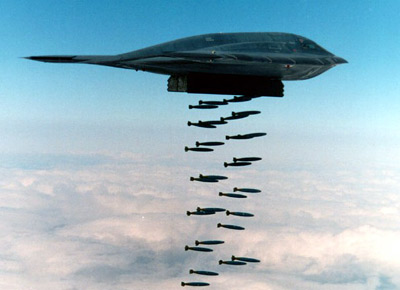 The B-2 packs two rotary launchers, housed in the center of the craft. When the mission commander is ready to fire, he or she sends a signal to the onboard computer. The computer opens the bomb bay doors, rotates the launcher to position the correct bomb and then releases that bomb.
The B-2 packs two rotary launchers, housed in the center of the craft. When the mission commander is ready to fire, he or she sends a signal to the onboard computer. The computer opens the bomb bay doors, rotates the launcher to position the correct bomb and then releases that bomb.
The launchers carry conventional gravity bombs -- "dumb" bombs that simply fall on their target -- as well as precision guided bombs that seek out their target. The plane can carry about 40,000 pounds of munitions.
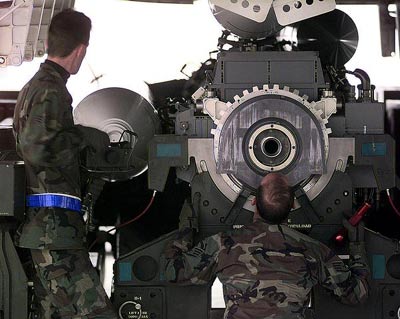
The B-2's precision guided bombs are actually "dumb" munitions with a separate guidance system attached. This guidance kit, known as Joint Direct Attack Munition (JDAM), includes adjustable tail fins, an inertial guidance system (a collection of sensors and a microcontroller) and a GPS receiver. The B-2 uses its own GPS receiver to pinpoint targets. Once the crew has located its target, they feed the target's GPS coordinates to the JDAM and release the bomb.
Computer Design
Northrop Grumman designed the B-2 bomber almost entirely on computers -- a radical departure from the traditional drafting methods. In the 1980s, this was a huge leap in technology. Engineers could build precise models of the aircraft, down to the smallest screw, and test out their stealth and efficiency in a virtual simulator.
The manufacturing process was also computerized. The computer guided extremely precise assembly robots to make sure every piece was in exactly the right position. It was crucial to prevent any errors because they could compromise the plane's stealth shape.
In the air, the JDAM's GPS receiver processes signals from GPS satellites to keep track of its own position. The inertial guidance system adjusts the JDAM's flight fins to guide the bomb to the intended target. This precise targeting system allows the B-2 to drop its bombs and make a quick escape. The bomb works fine even in bad weather, because the JDAM only needs to receive satellite signals to find its target. It doesn't have to see anything on the ground at all.
Because of its high cost and relative inexperience in the field, the B-2 is a fairly controversial weapon. While some analysts hold it up as the pinnacle of military aircraft, others say the plane has severe limitations, such as its stealth capabilities' high sensitivity to bad weather. But just about everybody agrees it is a pivotal development in the evolution of aeronautic technology. It is certainly an amazing machine.
 As you might expect, hiding a giant plane is no easy task. Northrop Grumman, the defense firm that won the bomber contract, spent billions of dollars and nearly 10 years developing the top secret project. The finished product is a revolutionary machine -- a 172-foot wide flying wing that looks like an insect to radar scanners! The craft is also revolutionary from an aeronautics perspective: It doesn't have any of the standard stabilizing systems you find on a conventional airplane, but pilots say it flies as smoothly as a fighter jet.
As you might expect, hiding a giant plane is no easy task. Northrop Grumman, the defense firm that won the bomber contract, spent billions of dollars and nearly 10 years developing the top secret project. The finished product is a revolutionary machine -- a 172-foot wide flying wing that looks like an insect to radar scanners! The craft is also revolutionary from an aeronautics perspective: It doesn't have any of the standard stabilizing systems you find on a conventional airplane, but pilots say it flies as smoothly as a fighter jet. 

 Flying wings have been around for a long time, but in the past, they suffered from major stability problems. Without the rear stabilizers, the plane tends to rotate around its yaw axis unexpectedly. The U.S. military didn't go for Northrop Grumman's earlier flying wing designs from the 1940s mainly because of these concerns.
Flying wings have been around for a long time, but in the past, they suffered from major stability problems. Without the rear stabilizers, the plane tends to rotate around its yaw axis unexpectedly. The U.S. military didn't go for Northrop Grumman's earlier flying wing designs from the 1940s mainly because of these concerns.  To do this, the aircraft needs to be nearly invisible in a number of different ways. Obviously, it needs to blend in with the background visually, and it needs to be very quiet. More importantly, it needs to hide from enemy radar as well as infrared sensors. It also needs to conceal its own electromagnetic energy.
To do this, the aircraft needs to be nearly invisible in a number of different ways. Obviously, it needs to blend in with the background visually, and it needs to be very quiet. More importantly, it needs to hide from enemy radar as well as infrared sensors. It also needs to conceal its own electromagnetic energy.  The engine system also works to minimize the plane's infrared (heat) signature. Infrared sensors, including those on heat-seeking missiles, typically pick up on hot engine exhaust. In the B-2, all of the exhaust passes through cooling vents before flowing out of the rear ports. Putting the exhaust ports on the top of the plane further reduces the infrared signature, since enemy sensors would most likely scan below the plane.
The engine system also works to minimize the plane's infrared (heat) signature. Infrared sensors, including those on heat-seeking missiles, typically pick up on hot engine exhaust. In the B-2, all of the exhaust passes through cooling vents before flowing out of the rear ports. Putting the exhaust ports on the top of the plane further reduces the infrared signature, since enemy sensors would most likely scan below the plane.  The second element in radar invisibility is the plane's shape. Radio waves bounce off planes in the same way light bounces off a mirror. A flat, vertical mirror will bounce your image straight back to you -- you'll see yourself. But if you tilt the mirror 45 degrees, it will reflect your image straight upward. You won't see yourself; you'll see an image of the ceiling. A curved mirror also deflects light at an angle. If you were to aim a laser pointer at a curved mirror, the laser beam would never bounce straight back to the pointer, no matter how you positioned it.
The second element in radar invisibility is the plane's shape. Radio waves bounce off planes in the same way light bounces off a mirror. A flat, vertical mirror will bounce your image straight back to you -- you'll see yourself. But if you tilt the mirror 45 degrees, it will reflect your image straight upward. You won't see yourself; you'll see an image of the ceiling. A curved mirror also deflects light at an angle. If you were to aim a laser pointer at a curved mirror, the laser beam would never bounce straight back to the pointer, no matter how you positioned it. 
